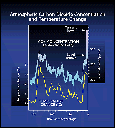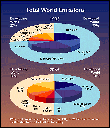         |
The Greenhouse Effect and Historical Emmissions
Life as we know it is possible on Earth because of a natural greenhouse
effect that keeps our planet about 60o F warmer than it otherwise
would be. Water vapor, carbon dioxide (CO2 ), and other trace gases, such as
methane and nitrous oxide, trap solar heat and slow its loss by re-radiation
back to space. With industrialization and population growth, greenhouse gas
emissions from human activities have consistently increased. These steady
additions have begun to tip a delicate balance, significantly increasing the
amount of greenhouse gases in the atmosphere, and enhancing their insulating
effect. carbon dioxide (CO2 ), and other trace gases, such as
methane and nitrous oxide, trap solar heat and slow its loss by re-radiation
back to space. With industrialization and population growth, greenhouse gas
emissions from human activities have consistently increased. These steady
additions have begun to tip a delicate balance, significantly increasing the
amount of greenhouse gases in the atmosphere, and enhancing their insulating
effect.
 A wide variety of activities contribute to greenhouse gas
emissions. Burning of coal, oil, and natural gas releases about 6 billion tons
of carbon into the atmosphere each year worldwide. Burning and logging of
forests contributes another 1-2 billion tons annually by reducing the storage
of carbon by trees. A wide variety of activities contribute to greenhouse gas
emissions. Burning of coal, oil, and natural gas releases about 6 billion tons
of carbon into the atmosphere each year worldwide. Burning and logging of
forests contributes another 1-2 billion tons annually by reducing the storage
of carbon by trees.  The result is that the atmospheric level of CO2, the most
important human-derived greenhouse gas, has increased 30 percent, from 280 to
360 parts per million The result is that the atmospheric level of CO2, the most
important human-derived greenhouse gas, has increased 30 percent, from 280 to
360 parts per million  (ppm) since 1860. Over the same time period, agricultural and
industrial practices have also substantially increased the levels of other
potent greenhouse gases -- methane concentrations have doubled and nitrous
oxide levels have risen by about 15 percent. These gases have atmospheric
lifetimes ranging from decades to centuries; today's emissions will be
affecting the climate well into the 21st century. (ppm) since 1860. Over the same time period, agricultural and
industrial practices have also substantially increased the levels of other
potent greenhouse gases -- methane concentrations have doubled and nitrous
oxide levels have risen by about 15 percent. These gases have atmospheric
lifetimes ranging from decades to centuries; today's emissions will be
affecting the climate well into the 21st century.
The overall emissions of greenhouse gases are growing at
 about 1 percent per year. For millennia, there has been a clear correlation
between CO2 levels and the global temperature record. Fluctuations of CO2 and
temperature have roughly mirrored each other over the last 160,000 years. The
current level of CO2 is already far higher than it has been at any point during
this period. If current emissions trends continue over the next century,
concentrations will rise to levels not seen on the planet for 50 million
years.
about 1 percent per year. For millennia, there has been a clear correlation
between CO2 levels and the global temperature record. Fluctuations of CO2 and
temperature have roughly mirrored each other over the last 160,000 years. The
current level of CO2 is already far higher than it has been at any point during
this period. If current emissions trends continue over the next century,
concentrations will rise to levels not seen on the planet for 50 million
years.
Which countries account for the largest proportions of CO2
emissions? In 1995, 73 percent of the total CO2 emissions from human
activities came from the developed countries. The United States is the largest
single source, accounting for 22 percent of the total, with carbon emissions
per person now  exceeding 5 tons per year. Over the next few decades, 90
percent of the world's population growth will take place in the developing
countries, some of which are also undergoing rapid economic development. Per
capita energy use in the developing countries, which is currently only 1/10 to
1/20 of the U.S. level, will also increase. If current trends continue, the
developing countries will account for more than half of total global CO2
emissions by 2035. China, which is currently the second largest source, is
expected to have displaced the United States as the largest emitter by 2015. exceeding 5 tons per year. Over the next few decades, 90
percent of the world's population growth will take place in the developing
countries, some of which are also undergoing rapid economic development. Per
capita energy use in the developing countries, which is currently only 1/10 to
1/20 of the U.S. level, will also increase. If current trends continue, the
developing countries will account for more than half of total global CO2
emissions by 2035. China, which is currently the second largest source, is
expected to have displaced the United States as the largest emitter by 2015.
Table of
Contents
President and First Lady | Vice President and Mrs. Gore
Record of Progress | The Briefing Room
Gateway to Government | Contacting the White House
White House for Kids | White House History
White House Tours | Help | Text Only Privacy Statement |

